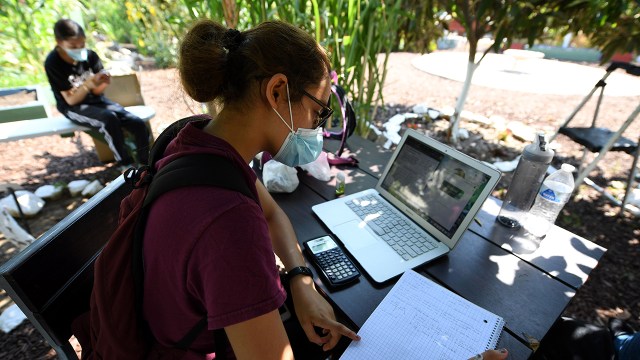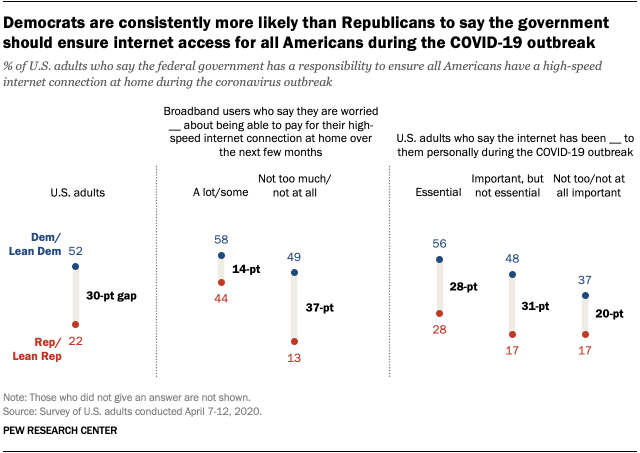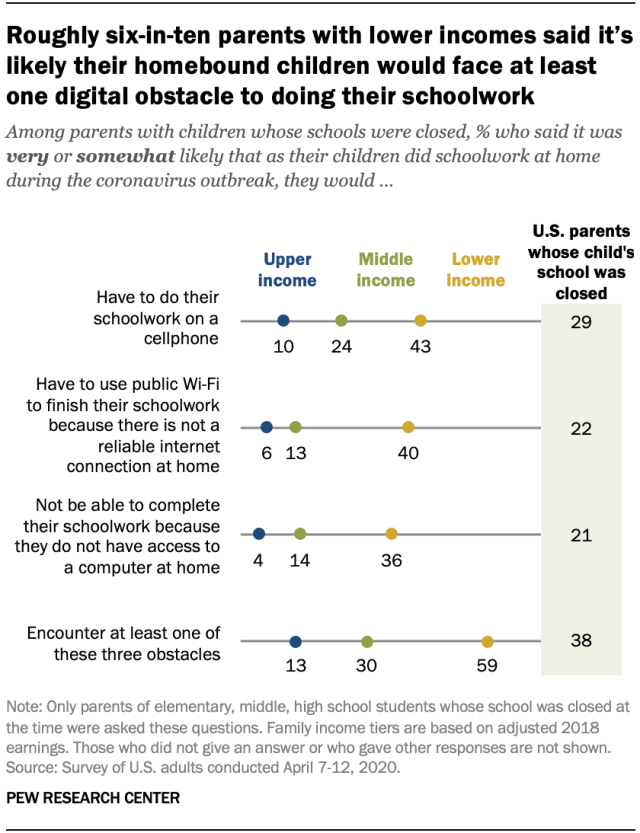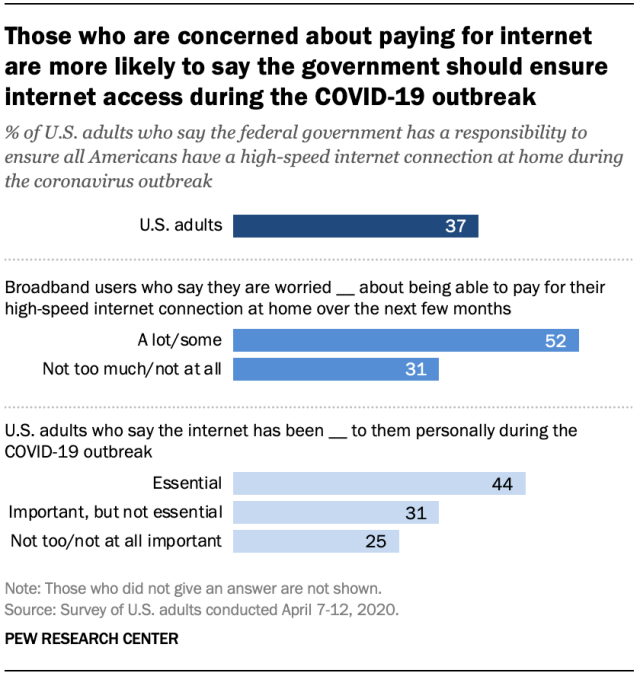
Communities across the United States are facing challenges of remote learning as K-12 schools have shifted to online classes or been forced to go remote after students or staff tested positive for COVID-19 early in the term.
Many of these schools faced similar problems in the spring. A new analysis of Pew Research Center data collected in early April finds that 59% of parents with lower incomes who had children in schools that were remote at the time said their children would likely face at least one of three digital obstacles asked about.
Overall, 38% of parents with children whose K-12 schools closed in the spring said that their child was very or somewhat likely to face one or more of these issues. In addition, parents with middle incomes were about twice as likely as parents with higher incomes to report anticipating issues.
Concerns related to the “homework gap” have affected families and driven policymakers for years. After the coronavirus outbreak shut down most of the country, including most K-12 schools, some parents reported worries about how their child would be able to complete their schoolwork from home, according to the Center’s April 7-12 survey of U.S. adults. At the time, 29% of parents with homebound schoolchildren said it was very or somewhat likely their children would have to do their schoolwork on a cellphone. About one-in-five parents also said it was at least somewhat likely their children would not be able to complete their schoolwork because they did not have access to a computer at home (21%) or would have to use public Wi-Fi to finish their schoolwork because there was not a reliable internet connection at home (22%).
Pew Research Center conducted this study to understand how Americans think about the role of the internet and computers amid the coronavirus outbreak. For this analysis, we surveyed 4,917 U.S. adults from April 7-12, 2020. Everyone who took part is a member of Pew Research Center’s American Trends Panel (ATP), an online survey panel that is recruited through national, random sampling of residential addresses. This way nearly all U.S. adults have a chance of selection. This gives us confidence that any sample can represent the whole U.S. adult population. (See our Methods 101 explainer on random sampling.) The survey is weighted to be representative of the U.S. adult population by gender, race, ethnicity, partisan affiliation, education and other categories. Read more about the ATP’s methodology.
Portions of this analysis cover different income groups. To create the upper-, middle- and lower-income tiers used in this report, family incomes based on 2018 earnings were adjusted for differences in purchasing power by geographic region and for household sizes. Middle income is defined as two-thirds to double the median annual income for all panelists. Lower income falls below that range; upper income falls above it. For more information about how the income tiers were determined, please read this.
Here are the questions used for this report, along with responses, and its methodology.
Those parental anxieties come at a time when there are debates about the role of schools in providing technology to students. Overall, the vast majority of Americans (80%) said in the April survey that they believed K-12 schools have a responsibility to at least some of their students to provide computers or tablets to help students complete their schoolwork during the outbreak, including 37% who said schools have this responsibility to all of their students.
Parents who anticipated at least one of these obstacles were more likely than others to say schools should provide computers to at least some students during the outbreak (92%) and that the government should ensure high-speed internet access to all Americans during the outbreak (57%). By comparison, fewer parents who expected their child to encounter no such challenges said the same (80% and 34%, respectively).
The internet has been important for many Americans, including non-parents, during the coronavirus outbreak. Nearly nine-in-ten Americans said the internet had been important or essential to them during the outbreak as of early April. However, only a minority believed it is the federal government’s responsibility to ensure all Americans have a high-speed internet connection at home during the outbreak.
Some groups – in particular, those who view the internet as essential or worry about affording it – were more likely to believe that the government should be responsible for ensuring internet access during the pandemic.
Overall, 37% of U.S. adults said in spring that the federal government has a responsibility to ensure all Americans have a high-speed internet connection at home during the outbreak, but this varied by people’s concerns about paying for these services.
Broadband users who were concerned a lot or some about paying for their internet over the next few months were 21 percentage points more likely than those who were not too or not at all worried to say the government has a responsibility to ensure internet access for all Americans during the outbreak (52% vs. 31%).
At the same time, the public’s views varied by the level of importance they placed on the internet during this time. While 44% of Americans who said the internet has been essential to them personally during this outbreak believed the government has a responsibility during the pandemic to ensure that all Americans have high-speed internet access, these shares were smaller among those who deemed the internet as important but not essential (31%) and those who described the internet during this time as not too or not at all important (25%).
Views on the issue also varied by partisanship. Overall, Democrats and independents who lean Democratic were more likely than Republicans and Republican leaners to say the federal government has a responsibility to ensure all Americans have a high-speed internet connection during the outbreak (52% vs. 22%). While the majority of Republicans (77%) opposed this initiative, it is worth noting that about half of Democrats (48%) also did not support government involvement.

When it came to partisan differences on this issue among broadband users, the gap between Democrats who were worried about affording their internet bills over the next few months and those who were not was relatively small. Some 58% of Democratic broadband users who worried about paying their internet bills backed the idea of government ensuring high-speed access during the pandemic, compared with 49% of the Democrats who weren’t worried about their broadband bills – a 9 percentage point difference. Among Republican broadband users in these different groups, there was a 31-point gap.
As many activities have been shifted online, the coronavirus outbreak has sparked debates about the digital divide – the gap between those who have access to technology and those who do not. One solution put forth by advocates would be to treat the internet as a public utility to which all citizens should have equal access.
Public support for government assistance on this issue is relatively low when compared with other areas. In a 2019 Center survey, 28% of U.S. adults said the federal government has a responsibility to provide access to high-speed internet to all Americans. Americans were much more likely to say the federal government has a responsibility to provide other support and services, such as high-quality K-12 education (80%), adequate medical care (73%) or health insurance (64%).
Note: Here are the questions used for this report, along with responses, and its methodology.




